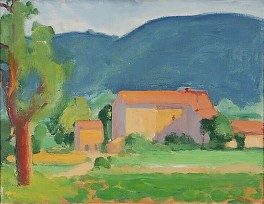BIOGRAPHY

American, 1928-
One of the last living students of Hans Hoffmann, Paul Resika was destined for fame early on: He had his first solo show at the George Dix Gallery in New York at the tender age of just nineteen, He is associated with the second generation of Abstract Expressionist artists in New York City who sought to meld the gestural emphasis and emotional immediacy of the Expressionists with their own representational subject matter. Resika’s work succeeds in seamlessly incorporating the abstract and the figurative within the context of a highly keyed color palette. One critic describes him thusly: "A modernist genre painter, a virtuosic colorist, and a realist painter who traffics in otherworldly moments, Resika has integrated so many idioms of abstraction into figuration that he seems to be giving a middle finger to the art world’s ever-changing avant-gardes."
Resika originally studied with the painter Sol Wilson and was permanently influenced by his seascapes. He then went to study with Hoffmann. There, he learned to render the voluminous nature of space and the “push-and-pull” interplay between color and form. “With Hofmann you had to draw forces,” Resika told Ira Goldberg of the Arts Student League, “there were no things. Everything was about relationships.”
Auspicious results under Hofmann sent Resika into the rarified orbit of leading painters from the New York scene. Before he turned 20, his Cubist-inflected works were earning Resika exhibition opportunities, notices in the New York Times, and the attention of tastemakers like Clement Greenberg and collectors like Leo Castelli. But despite these early successes, Resika felt he was missing a crucial foundation in anatomy and academic drawing. So in 1950, at a moment when artists around the world were moving to New York to seek out the bright lights of Abstract Expressionism, Resika decamped to Europe. On a parental allowance given in lieu of college tuition, he moved to Paris, then Rome, then finally Venice — to gain his education from the great masters of the western tradition. In Italy, he was galvanized by the Venetian School painters, especially Titian and Tintoretto. Back in America, investigating with bolder color and imprimatur techniques — painting as luminescence — bolstered his belief in the aesthetic value of traditions that had become uncool, like landscape and still life. He went one way and the Abstract Expressionists went another way.
Years went by, and wherever Resika went, he painted. His landscapes became progressively more saturated in color, taking them out of the natural, observed world and into the dream-like visions of a Fauvist Arcadia. Still, in the best of these works Resika somehow manages to retain an acute sense of particular light.
Yet the fact is, that Resika never left behind the lessons of Hoffmann. His more recent work is an exquisite rendering of relationships, quasi-abstract, geometric shapes and high-pitched color.
His work can be found in the collections of the Hecksher Museum, the Met, MOMA, the Whitney and many others.
